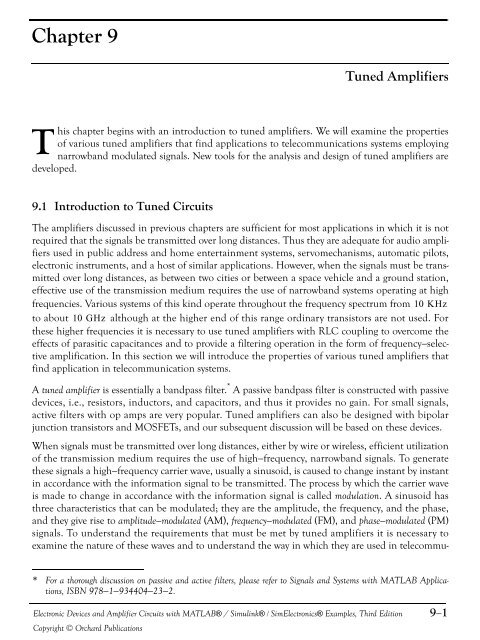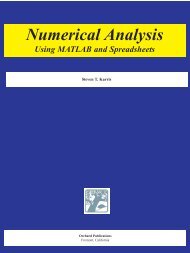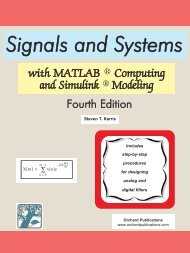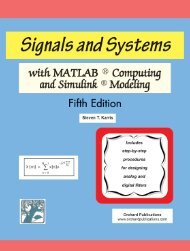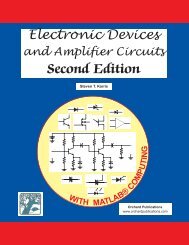Electronic Devices and Amplifier Circuits
Electronic Devices and Amplifier Circuits - Orchard Publications
Electronic Devices and Amplifier Circuits - Orchard Publications
Create successful ePaper yourself
Turn your PDF publications into a flip-book with our unique Google optimized e-Paper software.
Chapter 9Tuned <strong>Amplifier</strong>sThis chapter begins with an introduction to tuned amplifiers. We will examine the propertiesof various tuned amplifiers that find applications to telecommunications systems employingnarrowb<strong>and</strong> modulated signals. New tools for the analysis <strong>and</strong> design of tuned amplifiers aredeveloped.9.1 Introduction to Tuned <strong>Circuits</strong>The amplifiers discussed in previous chapters are sufficient for most applications in which it is notrequired that the signals be transmitted over long distances. Thus they are adequate for audio amplifiersused in public address <strong>and</strong> home entertainment systems, servomechanisms, automatic pilots,electronic instruments, <strong>and</strong> a host of similar applications. However, when the signals must be transmittedover long distances, as between two cities or between a space vehicle <strong>and</strong> a ground station,effective use of the transmission medium requires the use of narrowb<strong>and</strong> systems operating at highfrequencies. Various systems of this kind operate throughout the frequency spectrum from 10 KHzto about 10 GHz although at the higher end of this range ordinary transistors are not used. Forthese higher frequencies it is necessary to use tuned amplifiers with RLC coupling to overcome theeffects of parasitic capacitances <strong>and</strong> to provide a filtering operation in the form of frequency−selectiveamplification. In this section we will introduce the properties of various tuned amplifiers thatfind application in telecommunication systems.A tuned amplifier is essentially a b<strong>and</strong>pass filter. * A passive b<strong>and</strong>pass filter is constructed with passivedevices, i.e., resistors, inductors, <strong>and</strong> capacitors, <strong>and</strong> thus it provides no gain. For small signals,active filters with op amps are very popular. Tuned amplifiers can also be designed with bipolarjunction transistors <strong>and</strong> MOSFETs, <strong>and</strong> our subsequent discussion will be based on these devices.When signals must be transmitted over long distances, either by wire or wireless, efficient utilizationof the transmission medium requires the use of high−frequency, narrowb<strong>and</strong> signals. To generatethese signals a high−frequency carrier wave, usually a sinusoid, is caused to change instant by instantin accordance with the information signal to be transmitted. The process by which the carrier waveis made to change in accordance with the information signal is called modulation. A sinusoid hasthree characteristics that can be modulated; they are the amplitude, the frequency, <strong>and</strong> the phase,<strong>and</strong> they give rise to amplitude−modulated (AM), frequency−modulated (FM), <strong>and</strong> phase−modulated (PM)signals. To underst<strong>and</strong> the requirements that must be met by tuned amplifiers it is necessary toexamine the nature of these waves <strong>and</strong> to underst<strong>and</strong> the way in which they are used in telecommu-* For a thorough discussion on passive <strong>and</strong> active filters, please refer to Signals <strong>and</strong> Systems with MATLAB Applications,ISBN 978−1−934404−23−2.<strong>Electronic</strong> <strong>Devices</strong> <strong>and</strong> <strong>Amplifier</strong> <strong>Circuits</strong> with MATLAB® / Simulink® / Sim<strong>Electronic</strong>s® Examples, Third EditionCopyright © Orchard Publications9−1


